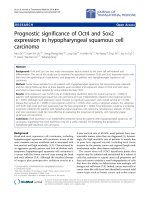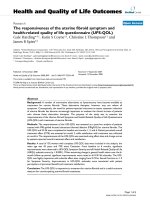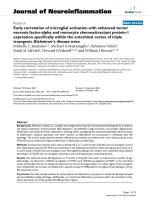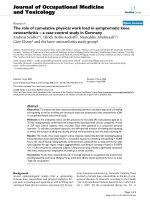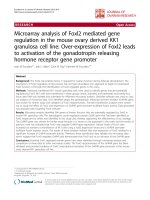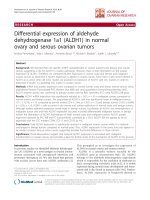báo cáo hóa học:" Greater involvement of people living with HIV in health care" potx
Bạn đang xem bản rút gọn của tài liệu. Xem và tải ngay bản đầy đủ của tài liệu tại đây (339.73 KB, 7 trang )
BioMed Central
Page 1 of 7
(page number not for citation purposes)
Journal of the International AIDS
Society
Open Access
Commentary
Greater involvement of people living with HIV in health care
Odetoyinbo Morolake*
1
, David Stephens
2
and Alice Welbourn
3
Address:
1
Positive Action for Treatment Access, Lagos, Nigeria,
2
Nossal Institute for Global Health, University of Melbourne, Victoria, Australia
and
3
International Community of Women Living with HIV/AIDS, London, UK
Email: Odetoyinbo Morolake* - ; David Stephens - ;
Alice Welbourn -
* Corresponding author
Abstract
Greater Involvement of People Living with HIV/AIDS represents a mobilising and an organising
principle for the involvement of people living with HIV in program and policy responses. People
with HIV have been at the forefront of designing and implementing effective HIV treatment, care
and prevention activities. However, governments and health systems have yet to act to fully harness
the potential and resources of people living with HIV in addressing the epidemic.
The lives and experiences of people living with HIV highlight the need for a shift in the existing
paradigm of disease management. The high prevalence of HIV amongst health care providers in
many countries, exacerbated by stigma towards those with HIV in the health care professions, is
seriously undermining the capacity of health systems and signals the need to change the current
nature of health care delivery. Moreover, the negative experiences of many people with HIV in
relation to their health care as well as in their daily social interactions, coupled with the ever-limited
current investment in treatment, care and support, demonstrate that the current system is
drastically failing the majority of people with HIV. Current health management systems urgently
need to be more effectively maximised, to increase the quality of standards of health care systems
and services in resource poor countries. An integrated approach to health care based on a human
rights framework, grounded in community realities and delivered in partnership and solidarity with
people living with HIV, offers the most viable approach to overcoming the crisis of HIV in the health
care system.
Background
The year 2008 marked the 30
th
anniversary of the Declara-
tion of Alma Ata, which was a first attempt to articulate
the goal of "public health for all" within a single policy
framework [1]. This year also marked the 60
th
anniversary
of the Universal Declaration of Human Rights, as well as
the establishment of the World Health Organization
(WHO). These anniversaries remind us that access to
health care and human rights are fundamental to our
struggle to improve the health and well-being of people
living with HIV; and that the attainment of the highest
possible level of health is the most important world-wide
social goal requiring the action and leadership of many
sectors – social, economic and legal – in addition to the
health sector. Indeed, all the Millennium Development
Goals (MDGs) relate in one form or another to health.
Unless the quality and breadth of health care systems
around the world are systematically improved, we will not
reach the targets set by the MDGs.
Published: 14 March 2009
Journal of the International AIDS Society 2009, 12:4 doi:10.1186/1758-2652-12-4
Received: 27 October 2008
Accepted: 14 March 2009
This article is available from: />© 2009 Morolake et al; licensee BioMed Central Ltd.
This is an Open Access article distributed under the terms of the Creative Commons Attribution License ( />),
which permits unrestricted use, distribution, and reproduction in any medium, provided the original work is properly cited.
Journal of the International AIDS Society 2009, 12:4 />Page 2 of 7
(page number not for citation purposes)
A lesser known, but equally important commemoration
in 2008 was the 14
th
anniversary of the principle of the
Greater Involvement of People Living with HIV and AIDS
(GIPA) in the response to the pandemic, [2]. It is deeply
shameful that we still have so far to go in realizing the
vision embodied in these declarations.
The authors of this paper also mark our own personal
anniversaries of survival with HIV, and we acknowledge
and salute the millions of people living with HIV around
the world who continue to inspire us and who are the true
authors of this story. We invite readers to come on a jour-
ney of what it means to be living with HIV and how it feels
when our health systems let us down. We invite you to
experience with us how it feels to know that as individuals
we have so much to offer our countries, our health sys-
tems and our communities; how it feels for that offer to be
ignored, forgotten or rejected; and how it feels to be stig-
matised and criminalised as 'carriers of HIV', or treated as
vectors of transmission. In this article we examine the cri-
sis of HIV and its impact on health systems in resource
poor settings. We also explore the glimmers of hope; the
work that people with HIV around the world are doing to
help reverse this crisis; and we offer an agenda to support
and strengthen these efforts.
The foundation of the Greater Involvement of People
living with HIV (GIPA)
We begin with a glance back at the history of the self-
empowerment and self-help movement of people with
HIV. The foundational right of all people to participate in
social, cultural and scientific activities is enshrined in the
1948 Universal Declaration of Human Rights, which
states that "Everyone has the right freely to participate in
the cultural life of the community, to enjoy the arts and to
share in scientific advancement and its benefits." (Article
27, paragraph 1) [3]. The right to participate in health care
systems and policies is also an important aspect of the
normative content of Article 12 (the right to health) of the
International Covenant on Economic, Social and Cultural
Rights. The United Nations Committee on Economic
Social and Cultural Rights has interpreted the right to
health to include the participation of the population in all
health-related decision-making at the community,
national and international levels [4].
On May 2, 1983, the first candlelight march led and
organised by people with HIV was held in San Francisco.
The goal was to draw attention to the plight of those with
HIV and AIDS, and remember those who had died. The
march was led by people with HIV holding a banner with
the slogan "Fighting for Our Lives", which became the
motto of the People with AIDS Self-Empowerment Move-
ment, and led to the drafting of the Denver Principles [5].
The Denver Principles are simple, but their significance
has been profound. They articulate the key challenges in
the lives of those living with HIV and the role of people
with HIV themselves in overcoming such challenges by
refusing to be victims and demanding to be involved.
The essential tenets of the Denver Principles are still rele-
vant today. The right of people with HIV to participate as
active and equal partners in the response to HIV and AIDS
finds its most recent articulation in the GIPA principle.
GIPA recognizes that the contribution of people with HIV
at all levels and in all sectors is critical to ethical and effec-
tive national responses to the epidemic [6]. GIPA is
important because it acknowledges the past contributions
people with HIV have made and it provides a vision for
the future in which people with HIV take their places as
equal partners with governments, donors, health workers
and others, working to stem the tide of the pandemic.
GIPA also represents an organising principle from which
we can shape our involvement as networks and groups
connected at the national and international levels. GIPA
serves as a necessary reminder of the importance of taking
active control of our lives and our health.
The nobel laureate Professor Wole Soyinka wrote:"The
man dies in all who keep silent in the face of tyranny"[7]. Eve-
ryday around the world, people with HIV continue to be
inspired by this ideal. These individuals speak out on
behalf of others, often at great risk, knowing that there are
many people, especially women, who want to speak out
about HIV, but cannot risk doing so for fear of risking
their livelihoods and their children.
The Role of people living with HIV in Health care systems
In its 2007 Framework for Action, WHO defines health
systems as all organizations, people and actions whose
primary interest is to promote, restore or maintain health
[8]. Health systems include a mother caring for a sick
child at home, private providers, behaviour change pro-
grammes, health insurance organizations, and occupa-
tional health and safety legislation. Health systems should
provide health and health equity in ways that are respon-
sive, financially fair and make the most efficient use of
available resources. Health systems are a collective
responsibility and, as the WHO Framework for Action
title indicates, "Everybody's Business". We have learnt the
hard way the truth of this statement, and that our health
outcomes rely on a broad set of institutions and systems,
as well as our communities and ourselves.
None of us living with HIV expected to have to learn so
much so fast about things we never imagined we would
need to face in life. Many of us – and many of our children
who have seen the effects of HIV in their own lives – have
either trained formally in the caring professions, includ-
ing health, or have informally become so-called "patient
Journal of the International AIDS Society 2009, 12:4 />Page 3 of 7
(page number not for citation purposes)
experts" on all kinds of aspects of HIV prevention, treat-
ment and care. "Impatient experts" would be a better way
to describe us. We are perhaps the most health and treat-
ment literate client body in the history of disease manage-
ment and this fact alone is of fundamental importance to
our role in HIV health care and treatment systems.
"The key to successful treatment education and advocacy is
remembering our own dignity as human beings and taking hold
of the power of that truth. Taking care of our feelings is as
important as understanding and treatment of the physical man-
ifestations of this disease. We are our own cure " Paisan
Suwannawong [9].
To understand the importance of the impact people with
HIV have made and are yet to make in the response to
HIV, we must acknowledge the place of people with HIV
in developing and striving for the foundational and most
effective responses to the epidemic. These include: the
concept of safe sex; the pioneering of harm reduction; the
value of peer education; progressive and inclusive policy
and law; the undocumented burden of caring; the insight
into treatment; the tireless work on prevention education;
the creation of supportive organizations and groups, often
in extremely hostile environments; and the human rights
campaigning and sacrifices of many people living with
HIV and AIDS.
People with HIV also have been instrumental in reshaping
critical areas of HIV research. From basic science to behav-
ioural and social research, the experience and knowledge
of people with HIV has been essential to setting a direc-
tion that is relevant, and that respects the rights of research
participants and can be translated into interventions
which make a practical and immediate difference.
Treatment activism has helped to change the way in which
drug trials are conducted and the approval process for the
release and access to new drugs [10,11]. Our engagement
has also led to a more open environment and the democ-
ratization of scientific knowledge. We have pushed the
scientific and publishing industry to create new pathways
for the sharing of knowledge, and we have created our
own. In social research our involvement helps to build the
trust between researchers and highly stigmatized and mar-
ginalized communities, helping researchers learn from
the experience and insight of communities.
HIV and the health system crisis
HIV is decimating the health workforce in many coun-
tries. The statistics are chilling, as shown by reports emerg-
ing from South Africa and Uganda [12,13]. At a recently
concluded workshop for bank staff conducted in Nigeria
by Positive Action for Treatment Access Nigeria, 70% of
participants believed that health care providers with HIV
should be prevented from conducting active clinical work
and invasive procedures [14]. Problems also exist in so-
called "developed" countries. In the United Kingdom,
many staff living with HIV employed by the National
Health Service are still terrified of their colleagues and
managers finding out their HIV status [15]. In Europe,
Young Positives Co-Founder Raoul Fransen recalled the
appalling way he was treated in medical school when he
disclosed his positive status. Things got so bad he decided
to take his considerable talents into public health instead
– luckily for all of us [16]. In Africa, our dear sister and
friend, Yinka Jegede, chose to stay and fight for her right
to remain in school and become a nurse when she was
diagnosed while still a 19 year old nursing student [17].
Official recruitment of HIV-positive people into the
health system is limited, and where it does happen, HIV-
positive people are mainly employed as peer supporters
and counsellors. These jobs are important, but the lack of
a proactive approach to recruiting and supporting staff in
more senior positions reflects and reinforces entrenched
stigma and discrimination. WHO is at last beginning to
challenge the paucity of opportunities for people with
HIV through its "Treat, Train and Retain" initiative, echo-
ing the important lead of UNESCO/EI-EFAIDS in support-
ing teachers living with HIV [18]. The GIPA statement
requires investment in people with HIV in order to estab-
lish the conditions in which we can become meaningfully
involved. Health workers living with HIV must be
affirmed and encouraged. Opportunities must be created
to help them become the very best they can be.
Until very recently, doubts about the capacities of health
systems and people with HIV to manage anti-retroviral
drugs, particularly in Africa, delayed the introduction of
treatment and led to the death of many. These doubts
were at best ill conceived and more often a thinly veiled
racist commentary on African people. Such attitudes
should not be allowed to block efforts to provide the best
quality care and the latest technology, including pap
smears, microbicides, and both female and male con-
doms. Yet people with HIV continue to suffer from drug
stock-outs, and limited paediatric formula for their chil-
dren. In 2008, three of the ten million people with HIV in
need of antiretrovirals (ARVs) are actually able to access
them [19].
For some, the risks of accessing HIV services may still out-
weigh the benefits. Entrenched judgements about sex
workers, men who have sex with men, transgender peo-
ple, drug users and women with HIV who choose to have
babies – despite the minimal risk to their children, if
proper health care is given – mean that quality care is
often simply not available. If this is hard to believe, ask
the women who have been coerced into having an abor-
Journal of the International AIDS Society 2009, 12:4 />Page 4 of 7
(page number not for citation purposes)
tion, or who have been sterilised. Ask the drug users who
have been locked up and made to suffer forced detoxifica-
tion and the loss of their liberty. Ask the men who have
sex with men and transgender people who are routinely
beaten and denied access to basic services [20,21].
Vertical versus integrated health care for people with HIV
Health systems are still struggling to integrate HIV care
with other services essential to supporting people living
with HIV. TB, malaria, sexually transmitted infections,
sexual and reproductive health, and mental health serv-
ices need to be integrated with HIV services. HIV high-
lights how ineffective a vertical approach to any health
issue is, as it seeks to squeeze people into boxes created by
management systems and delineated by professional
boundaries. This needs to be addressed urgently and
immediately, as the lack of integration or unavailability of
other essential services for people living with HIV cause
yet more hardship. The overriding imperative of HIV pre-
vention means, for example, that prevention of mother-
to-child transmission programmes are designed not as
comprehensive maternal and child health programmes,
but with the primary aim of producing HIV-negative
babies. They reconstruct women as biological vectors of
disease transmission, rather than as individual sentient
people with sexual and reproductive rights and human
desires to be loving and caring mothers [22].
Health systems, violence and criminalisation of HIV
transmission
Amnesty International, Physicians for Human Rights and
ICW have all documented the partner violence experi-
enced by countless women after testing positive [23-25].
This has its effect on the physical, sexual and mental
health of women, their children and babies. Women are
now also subject to criminal sanctions for transmitting
HIV (including to their children). We note that these legal
developments can be understood as a partial extension of
public health policies moving increasingly towards man-
datory testing [26].
Psychosocial support for HIV-positive people is desper-
ately needed around the world. A recent study in countries
in Asia and the Pacific found that 36% of patients had evi-
dence of depression [27]. Many abstracts published at the
XVII International AIDS Conference in Mexico also docu-
ment the widespread chronic depression experienced by
children, women and men alike, who are either HIV-pos-
itive or living with a family member who has HIV [28].
Even well intended health interventions can undermine
the broader health of people with HIV. A poster presenta-
tion at the same conference highlights the loss of auton-
omy and independence people experience as a
consequence of participating in DOT/ART programs,
thereby undermining adherence and regular clinic attend-
ance [29].
In so many affected regions, and particularly in Africa,
AIDS responses have been built around home based care
established and developed by communities. As mothers,
daughters, sisters and grandmothers, women carry the
burden of care whatever the nature of the epidemic and
are unheard, invisible, unpaid, and desperately over-
stressed. Girls too are deeply affected. They are the first to
be pulled out of school to help their mothers cope, the
first to have to use their bodies sexually to find alternative
sources of income, and the first to be sent off to work in
low paid jobs as house-servants, where they are frequently
exploited, or married off to relieve the household of one
less mouth to feed. A mapping exercise conducted by ICW
and funded by WHO found that women living with HIV
experience many types of social and economic barriers to
accessing treatment, and to ensuring that they are able to
adhere to treatment [30]. WHO has to date not reported
these findings in its literature; preferring to publish
reports simply stating that more women than men are
accessing ARVs from public health centres [31].
The work and achievements of people living with HIV
There are, however, many glimmers of hope and signs of
change. Stepping Stones ("Paso a Paso" in Spanish) is a
prevention initiative created out of personal positive expe-
riences, founded on the basis of care, respect, support for
and inclusion of everyone with HIV in a community [32].
The training package promotes gender equity, inter-gener-
ational respect and solidarity with HIV-positive people,
within a human rights framework. Reports of reductions
in gender violence using this programme are widespread
from many different countries [33].
Many thousands of people with HIV are actively involved
in prevention work and are not interested in spreading
this virus. The international community responding to
HIV should celebrate the work and sing the praises of the
many people with HIV around the world who are doing
their own bit, large or small, openly or undisclosed, to
make the world a better place for all around them [34,35].
There are many examples, including the work of Dr Lydia
Mungherera and her colleagues at the Mama's Club in
Uganda, who were the proud recipients of the 2008 Red
Ribbon Award for their great work in providing psycho-
social support for young positive mothers in Uganda.
Another example of positive leadership is Dr Jorge Saave-
dra Lopez, the openly positive director of Mexico's
National AIDS Control Centre. These inspirational people
have given us all so much. But these initiatives and coura-
geous people, as well as others like them, are struggling to
keep going. We need to rethink the response to make
Journal of the International AIDS Society 2009, 12:4 />Page 5 of 7
(page number not for citation purposes)
these islands of hope the mainstream, the norm and the
expected.
The way forward
We hope we have by now made the point that things will
not change unless people with HIV are centrally involved.
So we all need to step outside the predetermined manage-
ment- and system-focused boxes, to develop proper peo-
ple-centred not system-centred thinking and to create
holistic projects which reflect real lives. This means under-
standing that a functioning health system is everybody's
business. It means listening to, working with and support-
ing the meaningful involvement of people living with HIV
to understand how issues like law, food or violence inter-
connect, and how they affect HIV, health and health sys-
tems. The work of the Salvation Army in developing
human capacity development approaches, and of the
Cambodian HIV/AIDS Education and Care Initiative,
both of which support and build from community
responses, provide a principled and grounded approach
to HIV interventions which recognise that community
expertise and experience is critical to success [36,37].
In addition to contributing critical work in our communi-
ties, people with HIV have begun to participate in the gov-
ernance structures of the Global Fund and other
international bodies, as well as in senior management and
decision making roles. But huge gaps remain at the
national level. Governments, donors, National AIDS Con-
trol Programmes, lawmakers and nongovernmental
organization-led HIV programmes need to open their
doors to us.
The WHO HIV Department is beginning to commit to a
meaningful civil society consultation process, to recognise
the non-biomedical dimensions of this pandemic, and
respond to the health systems in a true holistic sense. We
urge WHO to encourage states throughout the world to
maintain data disaggregated by sex and age throughout
health care systems, and to use the global leverage and
leadership of WHO and the United Nations family to sup-
port people with HIV and challenge model laws that crim-
inalise transmission of HIV [38,39]. We also desperately
need Wellness Centres like those run by the Swaziland
Nurses Association, which provide treatment, care sup-
port and counselling for health workers and their families
[40,41]. These services are essential to keeping our highly
valued health workers alive.
We need to ensure universal access to halt and eventually
reverse the devastating losses to AIDS among all people
living with HIV. This means Greater "Investment" in the
"Lives" of People Living with – and directly affected by –
HIV and AIDS. All partners need to recognise and ade-
quately reward the roles people with HIV play and see us
as far more than volunteers and recipients of services. This
means enhancing our skills, and consulting with us when
programmes and policies that affect our lives are being
designed.
Funding for HIV has come under fierce criticism for draw-
ing funds away from other pressing health care needs. This
is not an either/or situation, nor is this argument sup-
ported by evidence [42]. An effective response to this pan-
demic must move beyond squabbles about AIDS versus
TB, AIDS versus malaria, or AIDS versus clean safe drink-
ing water or food security.
If the global arms trade and defence budgets were to dis-
appear overnight and be channelled into health care for us
all, these squabbles would vanish into the wind. Let's face
up to the real challenges of how the wealth of our world
is spent. We need more money for health care and more
money for HIV, not less. Recent events in the world's
financial markets and the responses of the rich countries
provide a stark example of how governments are willing
to invest huge financial resources in systems when faced
with the threat of global instability. We submit that the
health of the global poor, including people with HIV, con-
stitutes an equally compelling reason to act decisively and
invest in health and prosperity. Governments must
request Global Fund grants to address the massive health
worker shortages that are undermining all our efforts. This
includes funding for recurrent costs like salaries; for
efforts to reduce stigmatizing behavior by health workers;
money for treatment literacy; and money for health tech-
nology currently only available in the rich nations. Uni-
versal access must mean universal health standards
applicable to all, not just the fortunate few.
There is a clear need to place the expansion of health and
education services at the centre of national economic
planning if we are to see countries truly able to respond to
HIV and AIDS. This cannot be achieved unless govern-
ments are allowed to invest in health without the restric-
tions imposed by international financial organizations,
notably the International Monetary Fund [43,44].
Supporting the involvement of people living with HIV in
health care requires drastic steps to eliminate HIV-related
violence and discrimination. We have to stop violence
against women [45]. We have to stop institutional vio-
lence against sex workers, drug users, men who have sex
with men and transgender people. Human rights institu-
tions, governments and justice systems need to recognize
and act against the endemic violence that people with HIV
are subject to day after day.
Conclusion
People with HIV have done so much already. Through
personal journeys of pain, grief, and the realisations of
mortality, people with HIV have a rare gift to share with
Journal of the International AIDS Society 2009, 12:4 />Page 6 of 7
(page number not for citation purposes)
this world. In this article we have provided a brief glance
at the history of involvement and suggested how this can
and should be expanded. We believe this is important
because participation is founded on human rights princi-
ples and in the struggle of so many, and because it consti-
tutes a proven and vital partnership in health.
Competing interests
The authors declare that they have no competing interests.
Authors' contributions
All authors contributed equally to the design, structure
and content of the article. All authors read and approved
the final manuscript.
Acknowledgements
Jo Maher, Plurpol
Olive Shisana
Jane Lennon, Ann Smith and colleagues, The Catholic Agency for Overseas
Development (CAFOD)
Claudia Garcia-Moreno, WHO
Fiona Hale
Amandine Bollinger
Nigel Padfield
Eric Friedmann, Physicians for Human Rights
Ricardo Walters, Salvation Army
Sara Wilbourne, Saphia Crowther, Amnesty International
Ale Trossero, International Planned Parenthood Federation
Cambodian HIV/AIDS Education and Care
Oliver Ezeci
Morenike Ukpong
Uwemedimo Esiet
References
1. The International Conference on Primary Health Care 1978
Declaration of Alma-Ata [ />WHO/Policy/20010827_1]
2. Joint United Nations Programme on HIV/AIDS (UNAIDS): From
Principle to Practice: Greater Involvement of People Living
with or Affected by HIV/AIDS (GIPA). UNAIDS, Geneva 1999.
3. United Nations General Assembly (GA): Universal Declaration of
Human Rights. GA Resolution 217 A (III) of 10 December 1948
[ />].
4. United Nations Committee on Economic, Social and Cultural Rights:
General Comment No. 14 (2000). The right to the highest attain-
able standard of health (article 12 of the International Covenant on Eco-
nomic, Social and Cultural Rights) paragraph 11 [ />tbs/doc.nsf/(symbol)/E.C.12.2000.4.En].
5. The Advisory Committee of the People with AIDS: The Denver
Principles. [ />].
6. Opp: Cit UNAIDS. 1999.
7. Soyinka W: The Man Died. In Harper and Row, New York; 1972.
8. World Health Organization (WHO): Everybody's business:
strengthening health systems to improve health outcomes:
WHO's framework for action, 2007. 1972 [http://
www.searo.who.int/LinkFiles/
Health_Systems_EverybodyBusinessHSS.pdf].
9. The Collaborative Fund for HIV Treatment Preparedness
Fact Sheet, nd [ />].
10. Gonsalves G: ART Scale up. Plenary Presentation, XVII International
AIDS Conference, August 2008, THPL0103 [ />Pag/PSession.aspx?s=37].
11. Farmer P: Challenging Orthodoxies: the Road Ahead for
Health and Human Rights. Health and Human Rights 2008,
10.1:5-19.
12. Uebel KE, Nash J, Avalos A: Caring for the Caregivers: Models
of HIV/AIDS Care and Treatment Provision for Health Care
Workers in Southern Africa. Journal of Infectious Diseases 2007,
196(Suppl 3):S500-S504.
13. Shisana O: High HIV/AIDS prevalence among health workers
requires urgent action. S Afr Med J 2007, 97(2):108-109.
14. Odetoyinbo M: Personal communication. 2008.
15. Wiel M: Pos Medics Unmasked. Positive Nation. London 2004:114
[ />feature1.htm].
16. Opp: Cit Positive Medics Unmasked, Positive Nation. 2004.
17. The Elders: Every human has rights, 2008. Every Human Has
Rights Campaign [ />ekpe].
18. UNESCO and EI-EFAIDS, 2007: Supporting HIV-Positive Teachers in East
and Southern Africa: Technical Consultation Report. 30 November – 1
December 2006, Nairobi, Kenya. Paris, UNESCO .
19. UNAIDS: Report on the global HIV/AIDS epidemic 2008:
executive summary. [ />tre/HIVData/GlobalReport/2008/2008_Global_report.asp].
20. Human Rights Watch: Locked Doors: the Human Rights of Peo-
ple Living with HIV/AIDS in China. September 2003 [http://
www.hrw.org/reports/2003/china0803/china0903full.pdf].
21. UNAIDS: Report of the Meeting. UNAIDS Reference Group on HIV
and Human Rights. Seventh meeting 12–14 February 2007 Geneva
[ />20070703_rghr7_meetingreport_en.pdf].
22. Buskens I, Jaffe A: Demotivating infant feeding counselling
encounters in southern Africa: Do counsellors need more or
different training? AIDS Care 2008, 20(3):337-345.
23. Physicians for Human Rights: Epidemic of Inequality: Women's Rights and
HIV/AIDS in Botswana & Swaziland 2007 [http://physiciansforhuman
rights.org/library/documents/reports/botswana-swaziland-
report.pdf].
24. Amnesty International: "I am at the lowest end of all": Rural women living
with HIV face human rights abuses in South Africa 2008 [http://
www.amnesty.org/en/library/info/AFR53/001/2008/en].
25. International Community of Women Living with HIV/AIDS (ICW):
Violence against HIV Positive Women Briefing 2006. [http:/
/www.icw.org/files/Violence.pdf].
26. ICW: Concerned Over Trend to Criminalise HIV Transmis-
sion. [ />].
27. Wright E, Brew B, Arayawichanont A, et al.: Neurologic disorders
are prevalent in HIV positive outpatients in the Asia-Pacific
region. Neurology 2008, 71:53-59.
28. International AIDS Society XVII International AIDS Conference:
Abstract Book Volume 1 and Abstract Book Volume 2 2008.
. />and />29. Fraser DE: Debating Directly Observed Therapy (DOT) and
ARV Adherence among the Urban Poor. 2008 [http://
www.aids2008.org/abstract.aspx?elementId=200721083].
30. ICW: New Research On Women's Experiences of ACTS –
three reports from Kenya, Tanzania and Namibia. 2006
[ />].
31. World Health Organization: Towards universal access. Scaling up
priority HIV/AIDS interventions in the health sector. Progress Report 2008
[ />].
32. Welbourn A: Stepping Stones: A training package in HIV/
AIDS, communication and relationship skills. Oxford. Strategies
for Hope 1995.
Publish with BioMed Central and every
scientist can read your work free of charge
"BioMed Central will be the most significant development for
disseminating the results of biomedical research in our lifetime."
Sir Paul Nurse, Cancer Research UK
Your research papers will be:
available free of charge to the entire biomedical community
peer reviewed and published immediately upon acceptance
cited in PubMed and archived on PubMed Central
yours — you keep the copyright
Submit your manuscript here:
/>BioMedcentral
Journal of the International AIDS Society 2009, 12:4 />Page 7 of 7
(page number not for citation purposes)
33. Stepping Stones: "Transforming Male Gender Roles" Andrew
Levack. Global AIDS Link 2006, 100: [ppingstones
feedback.org/?page_id=287].
34. Maher J: The Impact of Increased Availability of Antiretroviral Therapy on
Programmes Responding to People Living with HIV and AIDS. London. Plur-
pol Consulting on behalf of CAFOD 2008 [
].
35. Kaleeba N: Perspective: Raising Africa's Orphans – Seeding a
"garden of hope" for children across the continent. 2008
World Pulse Magazine. [ />WPM_SPRING05.pdf].
36. Luca Susan, Rader Alison, Duongsaa Usa, Mphuka Simon, Campbell
Ian: Human Capacity development: learning from local
action and experience. Salvation Army 2002 [va
tionarmy.org/ihq/www_sa.nsf/766d2187c97e6bf180256cf4005d2284/
fdb5578e5e1a3c9280256f0e004aed0e/$FILE/Thai_report.pdf].
37. Maher J: The Impact of Increased Availability of Antiretroviral Therapy on
Programmes Responding to People Living with HIV and AIDS. London. Plur-
pol Consulting on behalf of CAFOD 2008 [
].
38. UNAIDS: Policy Brief: Criminalization of HIV Transmission,
2008. [ />20080731_jc1513_policy_criminalization_en.pdf].
39. Cameron E: Criminal Statutes and Criminal Prosecutions in
the Epidemic: Help or Hindrance? XVII International AIDS Confer-
ence, 2008. Plenary Presentation FRPL0103 .
40. Bactrin KM: Healthworkers and HIV: Changing the tide. Health
Rights Advocacy Forum (HERAF) Newsletter, Health Rights Advocacy
Forum, Kenya 2008, 4:2.
41. Physicians for Human Rights. Bold Solutions to Africa's Health
Worker Shortage. HERAF 2006:7-8.
42. International Treatment Preparedness Coalition: Treatment Monitoring
& Advocacy Project. Missing the Target: The HIV Response and Health Sys-
tems: Building on success to achieve health care for all 2008 [http://
www.aidstreatmentaccess.org/mtt6_final.pdf].
43. ActionAid: Changing IMF Policies to Get More Doctors,
Nurses and Teachers Hired in Developing Countries", 2008.
[
%20IMF%20and%20health.pdf].
44. Action Aid: Confronting the Contradictions: the IMF, Wage
Bill Caps and the Case for Teachers. 2007 [ion
aid.org/assets/pdf/AAConf_Contradictions_Final2.pdf].
45. García-Moreno C, Jansen H, Ellsberg M, Heise L, Watts C: Multi-coun-
try Study on Women's Health and Domestic Violence against Women: Ini-
tial results on prevalence, health outcomes and women's responses. World
Health Organization, 2005 2005 [ />who_multicountry_study/en/].

